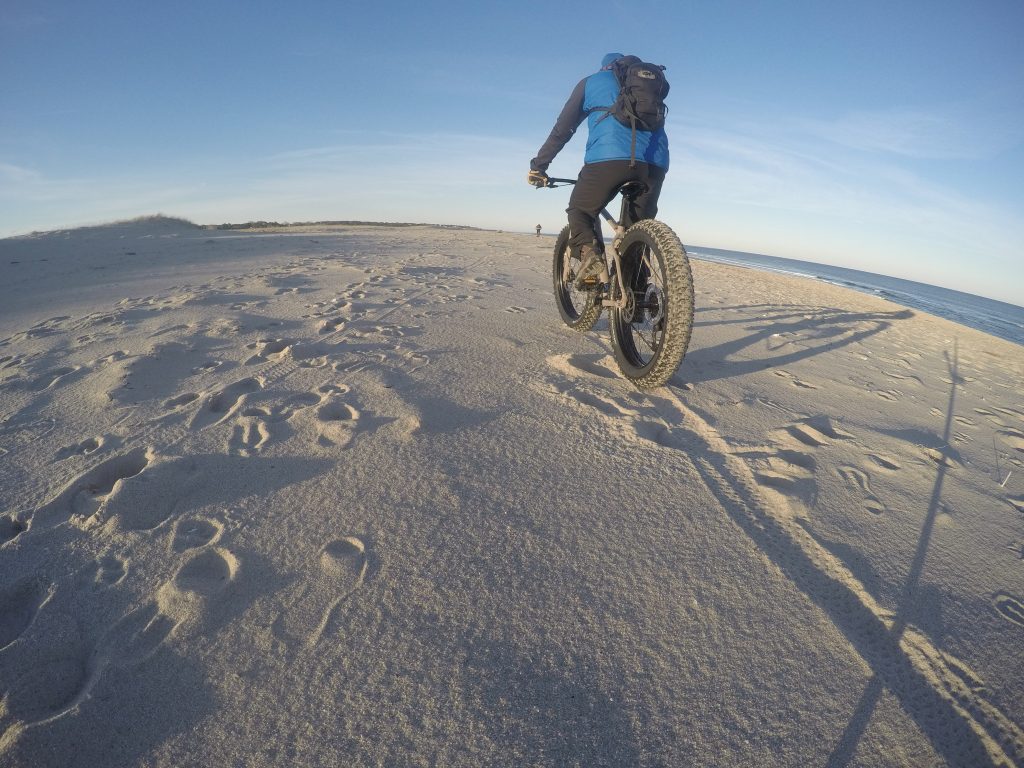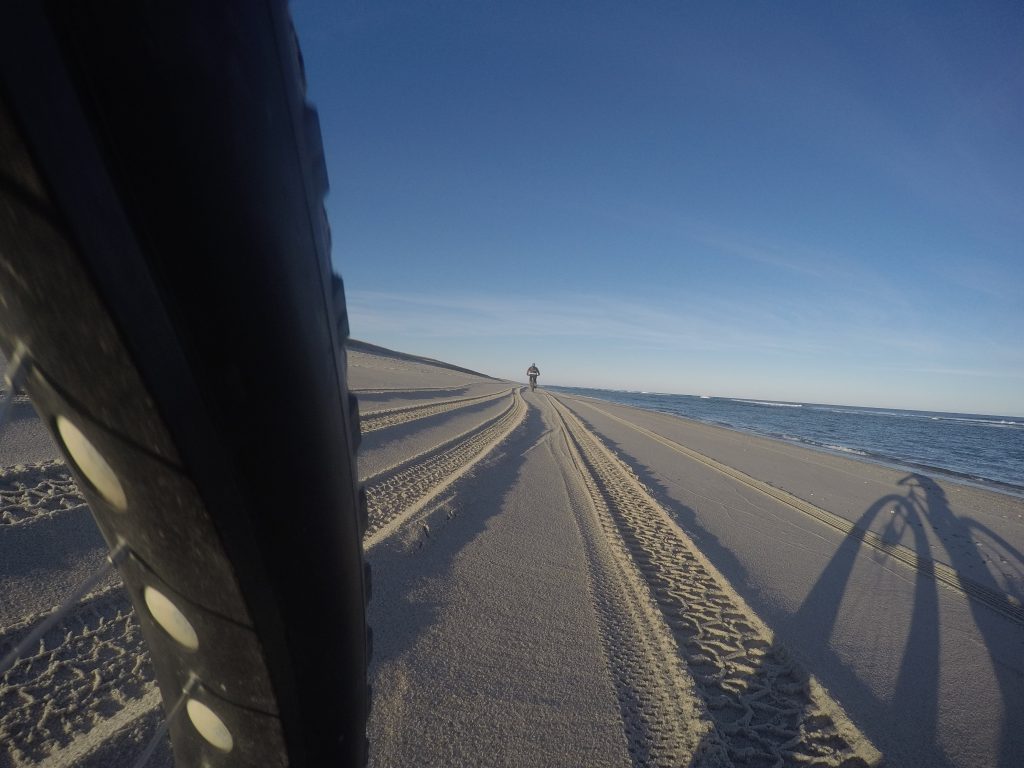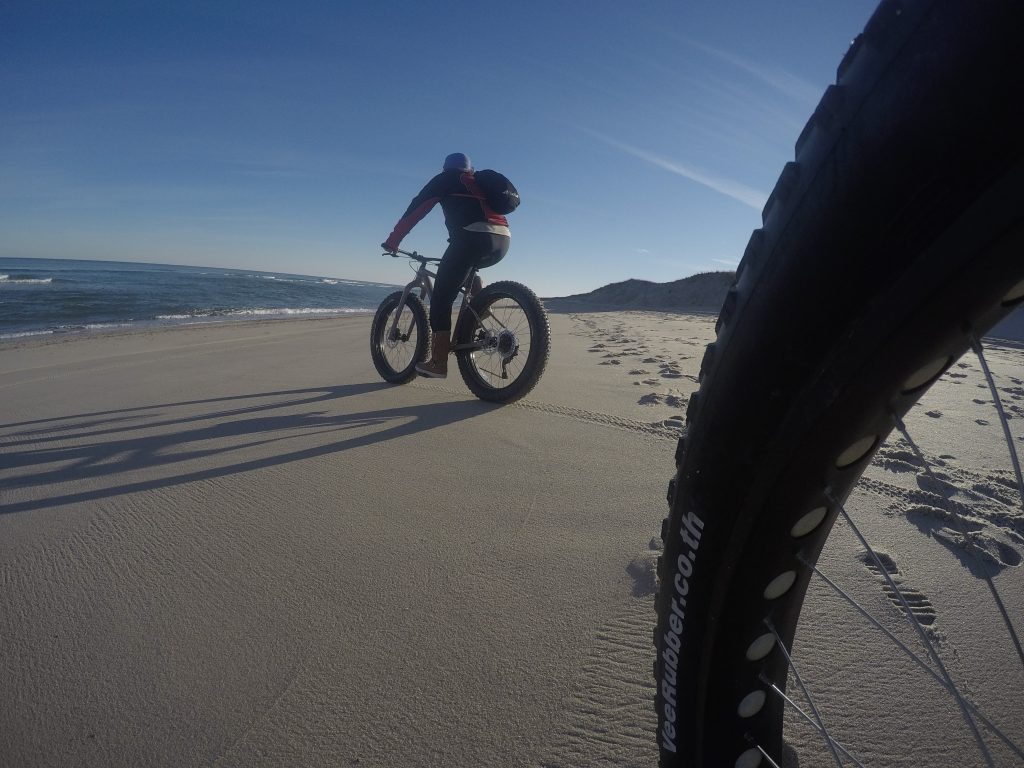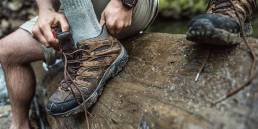Fall is a great time to explore Cape Cod: the weather is pleasant, the crowds have dissipated, and a chiller vibe emanates from the peninsula. There’s a reason some Cape Cod locals refer to autumn as the “local summer.” One of the best ways to explore the area’s coastline is by pedal power—but before putting some sand underneath your tires, here are a few tips for fat biking Cape Cod’s beaches.

10 Tips for Fat Biking on Cape Cod’s Beaches
The huge tires found on fat bikes and their ability to operate at low pressures allow them to more easily float on top of soft, sandy surfaces—like those found at the beach—than other types of bikes. That said, below are a few tips to make your first-time fat biking on the beach more enjoyable.
1. Know the Local Regulations
Most beaches on Cape Cod are open to bikes in the off-season. Sandy Neck Beach, the Brewster tidal flats, and the Nauset Beach ORV Road are all great jumping-off points for first-time Cape Cod fat bikers. However, fat bikes are not allowed on the beaches at Cape Cod National Seashore.
Know before you go and avoid ruffling any feathers (or nesting piping plovers) and check to make sure it’s OK before hitting the beach.
2. Avoid Restricted Areas
It’s common for beaches to restrict access to certain areas to protect wildlife, most notably nesting shorebirds. Demonstrate good stewardship of the places we play by respecting restrictions and sharing these beautiful stretches of coastline with our feathered friends.
Think the restrictions are silly? Efforts to protect nesting piping plovers have helped them rebound from just 135 breeding pairs in 1986 to more than 1,000 today!
3. Stay Off the Dunes
It might look fun to shralp down the super-steep dunes that line many Cape Cod beaches, but doing so will cause lasting damage. Sand dunes are fragile, easily eroded, and a vital part of the ecosystem. They’re also both home to wildlife and protection against coastal erosion. Simply stay off of them.
4. Check the Tides
Check the tide tables before heading out on your two-wheeled adventure. The tides go from high to low roughly every six hours and it’s possible that the stretch of shore you easily rode across at low tide is impassable at high tide.

5. Embrace the Intertidal Zone
Fat bikes are built to ride on a variety of terrain, however, they handle some surfaces better than others. The soft sand found farther from the shore offers a lot of resistance and can quickly tire out even the most energetic legs. Similarly, the heavy wet sand at the waterline can suck up a lot of pedaling power.
Aim to spend most of your time in the intertidal zone—it’s where you’ll find the most solid surface to ride on. The intertidal zone is the area between the wrack line (the line of debris left by the high tide) and the low water mark.
6. Low-Pressure Pedaling
The lower the pressure in your tires, the more flotation on the sand they provide. Conversely, they’re easier to pedal on solid surfaces, like paved roads, when inflated to higher pressures. I typically run my tires at 4 psi if I’m going to spend the majority of my time pedaling on the sand. I might run them higher (around 10 psi) if I am going to spend a fair amount of time riding on the road on my way to the beach.
I’ve gotten into the habit of carrying a mini pump and tire pressure gauge. This allows me to adjust the pressure in my tires to current conditions.
7. Pack a Bag
The Cape is known for its mild fall weather, but conditions can change fast. It gets cold quickly once the sun sets (which happens early in autumn) and a cool onshore breeze can make it feel significantly more frigid than the temperature indicates. A light puffy coat, a cozy fleece, and a warm winter hat are handy for staying comfortable in varying conditions—throw them in a bike-friendly pack before setting off on the sand.
Additionally, whether it’s getting splashed by a rogue wave or putting your foot down a little too close to the waterline, it’s easy to get wet while fat biking on the beach. Make sure to also toss a spare pair of socks in your pack to protect against frozen toes.
8. Bring a Camera
People flock to the Cape every summer for its beautiful beaches, but few see them from the seat of a bike, much less with minimal crowds. In other words, this is the perfect time to grab Insta-worthy images!
Plus, you never know what you’ll see. Last winter while riding Nauset Beach, I found a shark buoy that had broken loose during a storm. The Atlantic Shark Conservatory had been looking for it for a month!
9. Keep Up on Maintenance
Big rubber tires are adept at dealing with the sand and salt found at the seashore, however, beach riding can wreak havoc on a bike’s other parts, particularly drivetrains and brakes. After fat biking on the beach, give your bike a rinse using a bike-specific cleaner and hose. Avoid high pressures, which can push grime such as sand into a bike’s sensitive areas, like the headset and bottom bracket—think a calming shower, not a fire hose.
After your bike is clean, apply lube to the chain. Dry lubes are better than wet lubes, as they’re less likely to attract sand. Remember to wipe away any excess lube, which is a magnet for sand, dirt, and trail grime.

10. Have Fun!
Fat biking on Cape Cod’s beaches is a blast and a few simple steps and precautions can make it even better. Have fun, stay safe, and enjoy the ride.
Luke Foley
Luke Foley is passionate about discovering and sharing hidden local treasures and has long been a New England adventure enthusiast. After all, there are only a few places where you can skin for fresh tracks in the morning and have a sunset surf session on the same day.
Related Posts
April 24, 2024
What to Bring When Road Tripping with Your Dog
Prepare for the ultimate road trip with…




